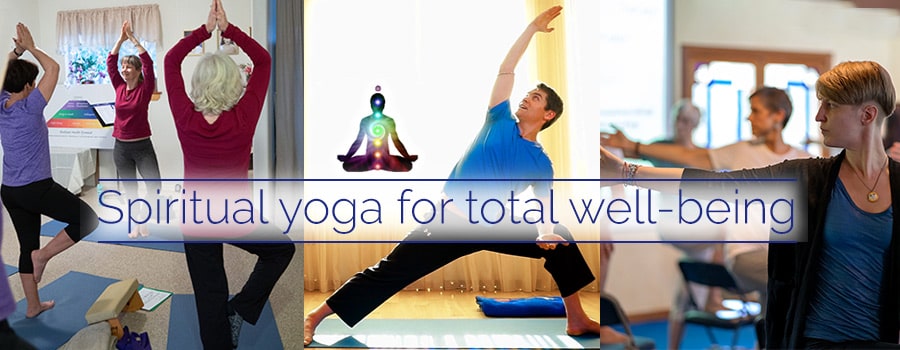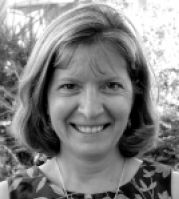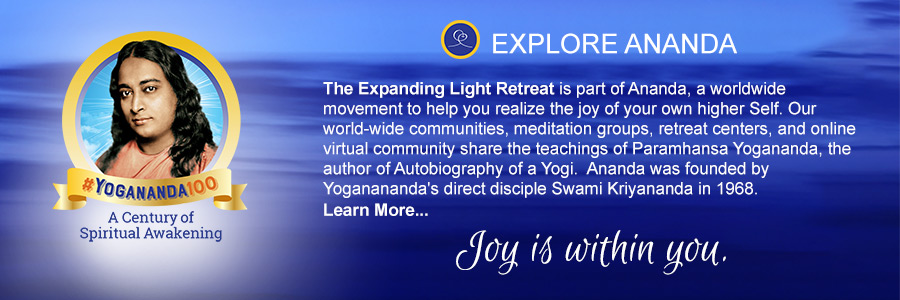Yoga as a Healing Modality
Last May, the University of Southern Indiana School of Nursing and Health Professions asked me to talk on “Yoga As A Healing Modality” to their Case Management Seminar.
It was quite a new topic for the participants (nurses, nurse practitioners, physicians, and corporate health insurance managers), as evidenced by other Seminar topics such as: “The Future of Case Management,” “Prospective Payment System Design for Rehabilitation,” “Managing Mental Health Issues in Your Practice,” and “Economics in Cardiology Care.”
But they were more interested in yoga!
My talk was “standing room only,” drawing far more people (approximately 60) than another concurrent workshop. It was quite an experience for all of us.
My friend Eddie demonstrated asanas as I spoke. I paused as he moved into a posture, then he said the affirmation and I repeated it. I didn’t explain the affirmations; I offered just a taste, letting them speak for themselves.

I also addressed the chakras only briefly. After all, “yoga as a healing modality” was new to this group, so I stayed primarily with information they could relate to: physical (for this audience, “yoga” is Hatha Yoga). Eddie’s demos and some overhead slides (both shown in italics) proved very helpful.
The Presentation
Hello, my name is Cecile Martin.
Eddie: Chandrasana
I am a nationally certified massage therapist, owner of “Bodyworks: Massage Therapy with Heart!”, and a therapeutic massage teacher with the Indiana College of Bodywork Modalities. I’m also a yoga instructor. I have studied yoga as a healing modality for almost 10 years now and have been asked to share with you what I’ve learned in my yoga training.
(I then introduced Eddie.)
Eddie: Forward bend (and variations) until Trikonasana
Overhead: Movement Is Life!
I was first introduced to yoga in 1991 through a friend from California who was visiting the Midwest for an extended time. I witnessed this friend practicing yoga postures and meditation, wondering what in the world could the benefits be of that? Holding the body for 30 seconds or longer in these weird-looking postures? Sitting motionless, eyes closed, for up to an hour at a time? I simply could not relate to it — until through some physical, emotional and mental challenges of my own, I ended up with a scheduled surgery in early 1992.
The closer the day came, the more I found myself opening to my own practice of yoga. Reading books, learning postures and breathing techniques, practicing creative visualization and affirmations, and eventually learning that the joy of yoga is not just the physical action…
Eddie: Trikonasana
… but the inner awareness that arises, seemingly from nowhere, while moving through the postures.
(I paused to watch Eddie and repeat after him: “Energy and joy flood my body cells! Joy descends to me!”)
I have learned that, like any other science, yoga is applicable to people of every clime and time. Yoga is a method for restraining the natural turbulence of thoughts, which otherwise impartially prevents all people from glimpsing their true nature of peace.
Eddie: Vrikasana
The thoughts of most persons are restless; a needs exists for yoga: the science of mind control. Yoga requires no formal allegiance; because the yogic science satisfies a universal need, it has a natural universal appeal.
Eddie: Virabhadrasana
There are a number of great men and women, some of whom live among us today, though they may never have heard the word “yoga,” are yet true exemplars of the term. Through their service to mankind (overhead: photo of Mother Teresa), or through their mastery over passions and thoughts (overhead: Dalai Lama), or through their single-hearted love and compassion for their fellow human beings (overhead: Abraham Lincoln), or through their great powers of concentration (overhead: Michael Jordan), they are, in a sense, yogis.
Among many thoughtful tributes to yoga may be mentioned one by Dr. C. G. Jung, the famous Swiss psychologist :
Eddie: Sun salutation
(Overhead:) “There is good cause for Yoga to have many adherents. It offers the possibility of controllable experience and thus satisfies the scientific need for ‘facts.’ The manifold, purely bodily procedures of Yoga mean a mental and physiological hygiene which is superior to ordinary gymnastics and breathing exercises, inasmuch as it is not merely mechanistic and scientific, but also philosophical; in its training of the parts of the body, it unites them with the whole of the spirit…”
Yoga comes from the Sanskrit root yug, which means “to join together” — the joining of the physical, emotional, mental and spiritual bodies. That is a grand concept to try to grasp. So we will begin with the physical body.
Eddie: Chandrasana
The physical body is made up, first, the skeleton, and in particular for the purpose of this talk, the spine.
Overhead: The spine
The spine “happens” to be in the center of our bodies, and it is particularly central to the practice of yoga. Take note for a moment the position in which your spine is resting at this moment. Hatha Yoga, the physical science of yoga, focuses on alignment of the spinal column. It is believed that the way we carry our bodies is a direct communication of what we think, or how we feel. When the shoulders are curled forward, chest caved in, spine curved, it is almost as if our bodies are saying to us “Hey, I’m carrying the weight of the world on my shoulders.”
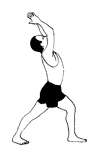
Eddie: Standing backward bend
When the spine is straight, with a gentleness to the action, the shoulders slightly back, chest slightly upraised, we immediately feel better. The “weight” is no longer pulling us down.
(I then guided them in experimenting with this.)
So the body responds to how we think. If we think “heavy,” so our bodies respond. If we think “light,” our bodies respond to that also.
Eddie: Circle of Joy
(Here I asked Eddie, rhetorically, “What is this about?”)
Overhead: nervous system
The nervous system is like the wiring of a computer. There are two systems of nerves: the central nervous system in the brain, medulla oblongata, and spinal cord; branching out from that is the peripheral nervous system, which connects the nerve centers to the different organs of the body and carries energy to them.
Eddie: Half-spinal twist
The brain is the core element of our central nervous system. Messages put into our bodies via thoughts through the brain, are sent directly down the trail of nerves into the body. For example: when we’re rushed, the kids needed to be at school 10 minutes ago, and at this point you know you will be at least 15 minutes late for work, the message your entire body is receiving from the brain is “rush, rush, hurry, hurry.” This throws all systems of the body into what is called the…
Eddie: Mime “fight or flight”
… “fight or flight” syndrome. Hormones secreted by the brain during this activity tell the adrenal glands to release more of the precious hormone adrenaline so that our bodies may meet the demands that our thoughts are telling us we must meet or else! The “wires” of the nervous system are on overload, and they quickly become worn or burned out.
Eddie: Slump to child’s pose
It is like hooking a 110-volt system to a 2000-volt outlet. The 110-volt nervous system just cannot handle the incredible output of the 2000 volts of emotional and mental activity.
The practice of Hatha Yoga postures helps to relieve this overload of the nervous system, and relieve the mind of “toxic” thoughts that feed our nervous system. Therefore, our minds become calm, sending messages of peace and harmony throughout the body. From this feeling of peace and harmony, comes strength.

Eddie: Pull up to Vajrasana
Strength in mind and in body. When we are strong in our thoughts, we are not as susceptible to misperceiving what others may be doing, or even how awful our lives may be. When we act from a center of peace and harmony, even when we realize we are running late, there is also a realization that there is not much we are going to be able to do about it anyway.
(Eddie, then I, affirmed: “My mind is firm and steadfast as a rock.”)
A special focus of Hatha Yoga postures happens to be breath awareness. Notice right now how your breath is flowing. Is it short and shallow? Long and deep? Eddie: Places hands on abdomen, then ribcage, then upper chest as an example for them to follow.
Settle into your chair, close your eyes and follow the movement of your breath. Extend the inhalation, then extend the exhalation. Place your hands on the abdomen as you breathe … then the bottom of the ribcage … then place tips of fingers at the collarbones. Notice the changes that take place by just this simple practice.
The breath is intimately tied to our thoughts. When we are functioning in the “fight or flight” or “fear” syndrome, the breath becomes quick and shallow. It is at that point that, what happens? The body becomes oxygen deprived. Oxygen is energetic food for the body. For the brain. So see how all of these systems are very intimately related to each other.
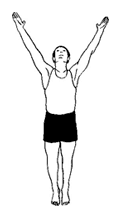
Eddie: Three deep, full yogic breaths as I watch
Yoga is the practice of mastering our thoughts and emotions. Such mastery is impossible when our nervous systems are over-amped. Yoga helps us regain enough control to begin to watch how we react to situations — and begin to realize that we have a choice: we can consciously respond or unconsciously react.
Though our actions often seem to be totally outside our conscious control, it’s only because of an overloaded nervous system.
(After a pause for questions, I briefly went over the chakras:)
Overhead: Chakras superimposed on physical body
Now I would like to talk about the aspect of yoga as energy medicine. Right behind the physical system of the body, we have an energetic system called the Chakra System. As you can see by the picture, the chakras are shown along the physical spine. The chakras are located in our energy bodies, not in our physical bodies. So you are not typically able to touch or see them, though there are people who can and do.
(I had the group rub their hands together, then hold the hands several inches apart to experience the feeling of energy.)
Energy healers work with the energy, or chakra system of the body. These chakras, or energy centers have corresponding locations in, and a great influence on, the physical body. As you can see by the picture, the energy body is superimposed over the physical body with the chakras as connecting points.
(I asked them to partner up: one seated, the other standing behind, first resting hands on shoulders, then holding hands an inch or so off the head and encouraging both partners to “feel.” It was a great experiment for them.)
I would like to jump back to the nervous system for a moment and show you how closely the physical nervous system is aligned with the energy or chakra system. Each of the major nerve plexes (or gathering centers) has a corresponding chakra. Or perhaps it would be more correct to say that each chakra has a corresponding nerve plexus, because the energy body precedes or causes the physical body to exist; the physical body is just a projection into matter of the subtle energy body.
The English names of the chakras are derived from the sections of the physical spine located closest to and controlled by that chakra.
Overhead: Chakras chart showing English name, location, faculties governed, and spiritual qualities.
(I then briefly took them through the chakra chart.)
So how do yoga postures free up tension or “energy blocks” within the body? There are many ways, but let’s focus on just one as Eddie does a series of postures called the Sun Salutation.
Eddie: Sun Salutation
Notice that his spine is moving in ways so as to release muscular tension along the spine. Though our awareness may be on physical movement and release of tension, there’s a subtle, energetic aspect to it. As I said earlier, the physical body is a manifestation of the energy body — you cannot affect one without affecting the other. Releasing physical tension in the physical spine helps release energetic blocks in the energy spine.
Hatha Yoga is an ancient science, developed in India long before the time of Christ. What the ancient yogis have passed on to us, through millennia of practitioners, is how, by hooking up the “wires” of the nervous system via these different postures, we can bring about definite physical, mental, emotional and spiritual evolution.
Overhead: Physical benefits of yoga
Yoga asanas (postures) are designed to give maximum flexibility and strength to the skeletal, muscular and nervous systems, with special emphasis on building a strong and supple spine, to the capacity of each individual. Asanas also massage internal organs and improve circulation, causing the release and distribution of vital hormones as well as supplying the brain and other cells with oxygen and other nutrients. Stretching asanas gently work out muscle tension so that muscles are able to relax more easily. The gradual strengthening of the nervous system builds concentration, poise and a more stable emotional nature.
Thank you very much. Any questions?
Editor’s note
Participants were extremely positive about Cecile’s presentation. Their evaluations indicated that they now felt better able to (1) discuss the practice of yoga as it relates to the enhancement of physical, mental, and spiritual health, and (2) describe how yoga may be utilized as an energy medicine modality.
They also felt that Cecile’s expertise and teaching strategies were very appropriate for the topic, and that her presentation was relaxing, enjoyable, informative, inspiring, and very interesting.
Congratulations and well done, Cecile!
Related
All authors are graduates of Ananda Yoga Teacher Training.



